Beauty trends are cyclical: In the 1980s Brooke Shields brought bold eyebrows into fashion; in the nineties Kate Moss set a trend for wearing them super thin; and now the bold brow is back thanks to Cara Delevingne.
But when it comes to changing standards of beauty, eyebrows are just the tip of the iceburg - a new BuzzFeed video shows just how dramatically the ideal has shifted from one century to the next and from one continent to another.
So which of the following historical trends is due a revival?
(We're placing our bets on the glued on unibrow.)
Ancient Egypt (c. 3150 - 31 BC)
![ancient egypt makeup]()
Get the look
Eyes: Lined with kohl and eyelids were often painted with green or blue eyeshadow.
Lips: Popular lip colors included orange, red, blue-black, and magenta.
Hair: Often braided, hair was worn long to frame the face.
Ancient Greece (c. 800 - 500 BC)
![ancient greek makeup]()
Get the look
Eyebrows: Unibrows were considered the height of beauty and women not lucky enough to be blessed with one naturally would often glue animal fur between their existing brows... yikes.
Eyes: Shadow in a natural shade so as not to detract from the power brow.
India’s Gupta Age (c. 320 - 550 A.D.)
![india gupta age makeup]()
Get the look
Eyes: Lined with kohl.
Lips: Coloured with lip rouge - an early predecessor of lipstick.
Hair: Worn in a low bun or a braid and often decorated with flowers.
Bindi: Only worn by married Hindu women at this time.
Elizabethan Era (c. 1558 - 1603)
![elizabethan makeup]()
Get the look
Skin: Heavily dusted with powder.
Lips: Bold lip rouge was all the rage.
Forehead: It's not often the forehead has it's beauty moment, but in the Elizabethan era it was considered a sign of great beauty to have a large forehead, and many women shaved their hairline and their eyebrows to make theirs appear larger.
Japanese Geishas (c. mid-1700s)
![japanese geisha makeup]()
Get the look
Skin: Heavy white foundation was taken right down to the neckline and around to the back of the neck, where it finished a couple of inches below the hairline in a 'w' shape.
Lips: Covered with foundation and then redrawn in the shape of a flower bud using a red lip colour on a lip brush.
Eyes: Lined with black charcoal along the top eyelashes and red along the bottom lash line.
Pre-French Revolution (c. 1775 - 1789)
![prefrench revolution makeup]()
Get the look
Cheeks: Apply red rouge liberally.
Lips: Kept shiny with... grease - if you're planning on kissing anyone you may not want to go too authentic with this look, thankfully we can now achieve the same result with lipgloss.
Skin: It was fashionable to draw beauty marks on cheeks with charcoal - but many women didn't stop there, they also drew veins on their décolletage - perhaps this was an early precursor of contouring your cleavage with bronzer?
Victorian Era (c. 1837 - 1901)
![victorian makeup]()
Get the look
Queen Victoria publicly stated that wearing makeup was impolite, and so ushered in an age of 'the natural look' - in other words, make-up that doesn't look like you're wearing make-up.
Skin: Very lightly powdered to hide any spots.
Cheeks: No need for blusher when a couple of pinches will bring on a natural glow.
Hair: Worn long but swept up at the back of the head in a chignon.
Swingin’ Sixties (c. 1960 - 1969)
![sixties makeup]()
Get the look
Lips: Pale pink lipstick was the height of fashion.
Eyes: Stood out with brightly coloured eyeshadow and false lashes.
Cheeks: A hollow look was created using different shades of blusher to contour.
Hair: The bigger, the better. Wear a large bouffant wig if need be.
BuzzFeed aren't the first to look at how beauty standards have changed over the years. The Cut have created a series of videos which look at the history of beauty in one country over the last hundred years.
The Cut's clips go a little further than BuzzFeed's fun tutorials and provide a fascinating insight into how changes in a country's economy and political landscape are reflected in the appearances of the women who live there.
But when it comes to changing standards of beauty, eyebrows are just the tip of the iceburg - a new BuzzFeed video shows just how dramatically the ideal has shifted from one century to the next and from one continent to another.
So which of the following historical trends is due a revival?
(We're placing our bets on the glued on unibrow.)
Ancient Egypt (c. 3150 - 31 BC)

Get the look
Eyes: Lined with kohl and eyelids were often painted with green or blue eyeshadow.
Lips: Popular lip colors included orange, red, blue-black, and magenta.
Hair: Often braided, hair was worn long to frame the face.
Ancient Greece (c. 800 - 500 BC)

Get the look
Eyebrows: Unibrows were considered the height of beauty and women not lucky enough to be blessed with one naturally would often glue animal fur between their existing brows... yikes.
Eyes: Shadow in a natural shade so as not to detract from the power brow.
India’s Gupta Age (c. 320 - 550 A.D.)
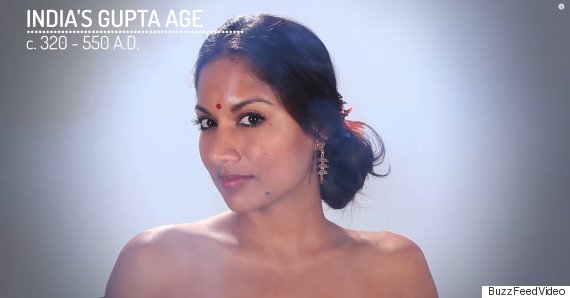
Get the look
Eyes: Lined with kohl.
Lips: Coloured with lip rouge - an early predecessor of lipstick.
Hair: Worn in a low bun or a braid and often decorated with flowers.
Bindi: Only worn by married Hindu women at this time.
Elizabethan Era (c. 1558 - 1603)
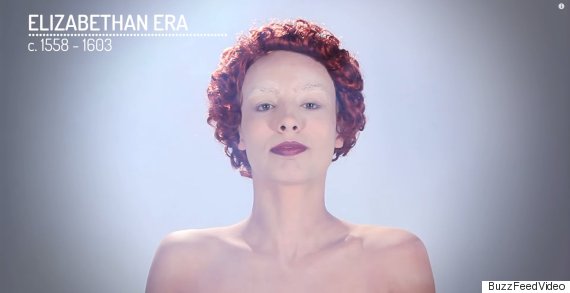
Get the look
Skin: Heavily dusted with powder.
Lips: Bold lip rouge was all the rage.
Forehead: It's not often the forehead has it's beauty moment, but in the Elizabethan era it was considered a sign of great beauty to have a large forehead, and many women shaved their hairline and their eyebrows to make theirs appear larger.
SEE MORE
Watch 100 Years Of Beauty In One Minute
Beauty Hacks For Lazy Girls: How To Apply Your Make-Up Quickly
Japanese Geishas (c. mid-1700s)
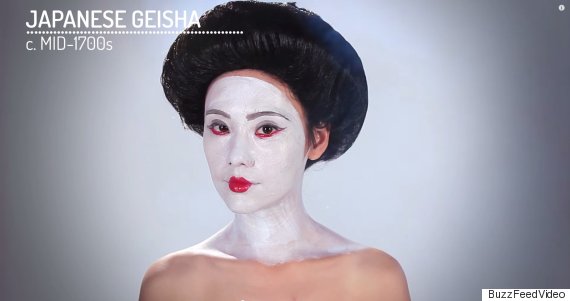
Get the look
Skin: Heavy white foundation was taken right down to the neckline and around to the back of the neck, where it finished a couple of inches below the hairline in a 'w' shape.
Lips: Covered with foundation and then redrawn in the shape of a flower bud using a red lip colour on a lip brush.
Eyes: Lined with black charcoal along the top eyelashes and red along the bottom lash line.
Pre-French Revolution (c. 1775 - 1789)
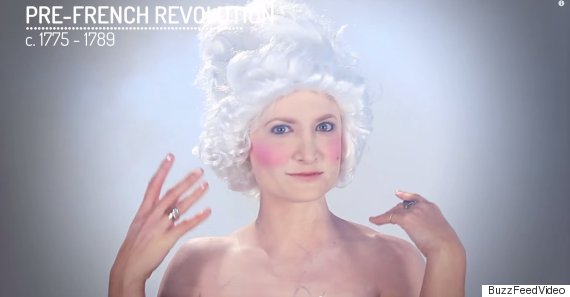
Get the look
Cheeks: Apply red rouge liberally.
Lips: Kept shiny with... grease - if you're planning on kissing anyone you may not want to go too authentic with this look, thankfully we can now achieve the same result with lipgloss.
Skin: It was fashionable to draw beauty marks on cheeks with charcoal - but many women didn't stop there, they also drew veins on their décolletage - perhaps this was an early precursor of contouring your cleavage with bronzer?
Victorian Era (c. 1837 - 1901)
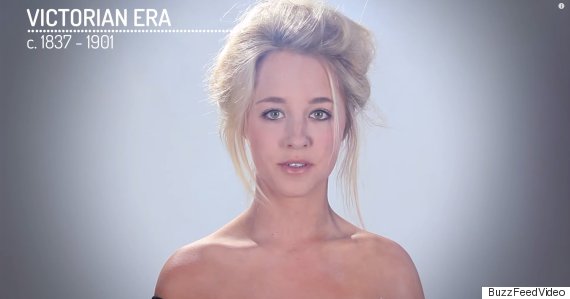
Get the look
Queen Victoria publicly stated that wearing makeup was impolite, and so ushered in an age of 'the natural look' - in other words, make-up that doesn't look like you're wearing make-up.
Skin: Very lightly powdered to hide any spots.
Cheeks: No need for blusher when a couple of pinches will bring on a natural glow.
Hair: Worn long but swept up at the back of the head in a chignon.
Swingin’ Sixties (c. 1960 - 1969)
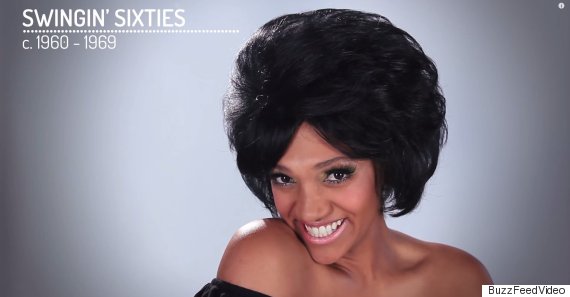
Get the look
Lips: Pale pink lipstick was the height of fashion.
Eyes: Stood out with brightly coloured eyeshadow and false lashes.
Cheeks: A hollow look was created using different shades of blusher to contour.
Hair: The bigger, the better. Wear a large bouffant wig if need be.
BuzzFeed aren't the first to look at how beauty standards have changed over the years. The Cut have created a series of videos which look at the history of beauty in one country over the last hundred years.
The Cut's clips go a little further than BuzzFeed's fun tutorials and provide a fascinating insight into how changes in a country's economy and political landscape are reflected in the appearances of the women who live there.